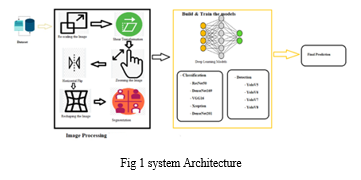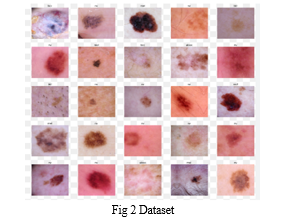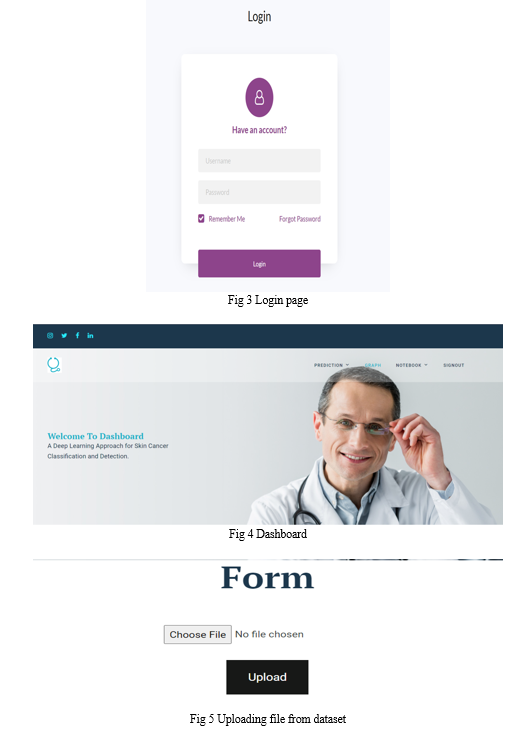Ijraset Journal For Research in Applied Science and Engineering Technology
- Home / Ijraset
- On This Page
- Abstract
- Introduction
- Conclusion
- References
- Copyright
Intelligent Skin Cancer Detection with Preliminary Diagnosis using CNN
Authors: K Ragini, P Yamini Nikitha, M Mythilee, N Priyanka, K Poojitha
DOI Link: https://doi.org/10.22214/ijraset.2024.63541
Certificate: View Certificate
Abstract
This paper addresses the critical need for early and accurate diagnosis of skin cancer, a prevalent global health concern. Recognizing the challenges posed by prolonged waiting times and subjective evaluations in clinical set things, the study focuses on leveraging deep learning techniques to enhance skin disease classification and detection. The research confronts the inherent class imbalance issue, where the number of affected classes is notably lower than the healthy class and strives to elucidate the decision-making processes employed by the models. The authors suggest a comprehensive smart healthcare system implemented through an Android application from start to finish. Evaluating the effectiveness of the proposed deep learning technique, the study utilizes ResNet50, DenseNet169, VGG16, Xception, and DenseNet201 for classification, with Xception achieving a notable 96% accuracy. Additionally, YoloV5, YoloV6, YoloV7, and YoloV8 models are employed for skin lesion detection. Notably, ResNet50 attains a commendable 90% training accuracy, while Xception demonstrates potential for further performance enhancement. This comprehensive exploration of diverse models and techniques contributes to advancing skin cancer diagnosis, emphasizing the importance of accuracy in patient outcomes.
Introduction
I. INTRODUCTION
Skin ailments represent a substantial public health issue on a global scale, impacting millions regardless of age, gender, or ethnicity. The diagnosis of such conditions frequently demands the specialized knowledge of dermatologists, potentially resulting in treatment delays and elevated healthcare expenditures. In recent times, the utilization of deep learning methods in medical imaging has displayed potential in automating the identification and diagnosis of a spectrum of illnesses, encompassing skin disorders.
Deep learning, a branch of artificial intelligence, entails training neural networks with extensive datasets to identify patterns and provide predictions. Convolutional Neural Networks (CNNs), a specific type of deep learning architecture, have exhibited impressive performance in recognizing images, rendering them ideal for detecting skin diseases. Through annotated images of diverse skin conditions, CNNs can discern between different ailments with exceptional accuracy. This paper endeavors to explore the potential of deep learning in the initial diagnosis of skin diseases by crafting a CNN-based model proficient in identifying common dermatological conditions from images. This proposed model aims not only to facilitate early detection but also to serve as a valuable resource for healthcare providers in regions with limited access to dermatologists.
This paper investigates techniques in deep learning for the classification and detection of skin diseases, addressing challenges in clinical evaluation. With a focus on class imbalance, ResNet50, Dense Net161, VGG16, Xception, and DenseNet201 are explored for classification, while YoloV5, YoloV6, YoloV7, and YoloV8 are applied for skin lesion detection in an end-to-end smart healthcare system. This research aims to address challenges in skin disease diagnosis, including prolonged waiting times and subjective interpretations in clinical evaluations.
II. LITERATURE SURVEY
Skin diseases pose a significant burden on public health globally, with a wide range of dermatological conditions affecting individuals of all ages and demographics. As technology progresses, particularly in artificial intelligence (AI) and deep learning, there's a burgeoning interest in harnessing these tools for identifying and diagnosing skin diseases. This literature review seeks to outline recent advancements in applying deep learning methods to classify and diagnose skin lesions, emphasizing convolutional neural networks (CNNs) and their adaptations.
AlSalman et al. [1] undertook research on nonmelanoma skin cancer (NMSC) in Saudi Arabia, highlighting the importance of understanding the epidemiology and clinical characteristics of skin cancer in different populations. The authors emphasized the need for accurate diagnostic tools to improve patient outcomes and healthcare management.
Building upon this foundation, researchers have investigated different deep learning methodologies to improve the precision and effectiveness of diagnosing skin diseases.
Albahar [2] introduced a new regularizer for CNN to enhance the classification accuracy of skin lesions. The regularization techniques introduced to the model improved the model's ability to differentiate between different skin lesions, resulting in more precise diagnosis and treatment. Similarly, Hasan et al. [3] carried out a benchmarking exercise of benign and malignant skin lesions using CNNs, highlighting the potential of deep learning algorithms in differentiating between various disease states based on imaging data.
Ajagbe et al. [4] extended the application of deep CNNs to the Alzheimer's disease classification using magnetic resonance images (MRI). While not directly related to dermatology, this study underscores the versatility of deep learning methodologies applied to medical image analysis and classification endeavors. Barata et al. [5] suggested a deep attention model for the hierarchical diagnosis of skin lesions, which incorporates attention mechanisms to focus on relevant characteristics during the classification procedure. This approach enhances the interpretability of the model's decisions and improves diagnostic accuracy.
Kassem et al. [6] investigated the utilization of transfer learning and deep CNNs for skin lesion categorization into eight classes using the ISIC 2019 dataset. Transfer learning leverages pre-trained models on large datasets to extract meaningful characteristics from medical images, leading to enhanced training efficiency and improved generalization performance.
Shahin et al. Li and Shen [7] focused on melanoma detection using deep learning networks, emphasizing the importance of early diagnosis in improving patient outcomes. Their study highlighted the potential of deep learning algorithms in analyzing skin lesion images and detecting malignant melanoma with high sensitivity and specificity.
Overall, the literature survey highlights the growing body of research on utilizing deep learning methods for diagnosing and classifying skin diseases. From improving accuracy in distinguishing between benign and malignant lesions to enhancing interpretability and efficiency in diagnosis, deep learning offers promising solutions for addressing the challenges associated with skin disease management. Nevertheless, additional research is required to corroborate these discoveries within clinical settings and tackle associated challenges. such as dataset bias, model interpretability, and integration into healthcare systems.
III. METHODOLOGY
A. Proposed Work
The proposed system pioneers a comprehensive approach to skin cancer diagnosis by integrating advanced deep learning techniques into an end-to-end smart healthcare system. Targeting the limitations of lengthy waiting times and subjective interpretations in clinical assessments, the system employs ResNet50, Dense Net161, VGG16, Xception, and DenseNet201 for skin cancer classification. Emphasis is placed on mitigating the class imbalance problem inherent in skin-related datasets. Additionally, YoloV5, YoloV6, YoloV7, and YoloV8 models are deployed for precise skin lesion detection, contributing to a holistic diagnostic framework. The Android application serves as a user-friendly interface, facilitating seamless interaction and interpretations of results. By providing an integrated solution, this proposed system not only enhances the accuracy of skin cancer diagnosis but also offers clinicians a deeper understanding of the decision-making mechanisms employed by the models. The integration of diverse models and the end-to-end nature of the system mark a significant stride toward efficient, accessible, and accurate skin cancer diagnostics in clinical practice.
B. System Architecture
The suggested system framework shown in fig 1 consists of four primary components: dataset management, image pro cessing, model building and training, and final prediction. Firstly, the dataset management module handles the collection, preprocessing, and organization of skin lesion images, ensuring data quality and integrity. Next, the image processing component applies methods like resizing, normalization, and augmentation to improve both the quality and diversity of the dataset. The model building and training phase utilizes a variety of deep learning architectures including ResNet50, DenseNet169, VGG16, Xception, and DenseNet201 for skin lesion classification. Additionally, for lesion detection, the system incorporates YOLO (You Only Look Once) models such as YOLOv5, YOLOv6, YOLOv7, and YOLOv8. Finally, the final prediction module integrates the outputs from the classification and detection models to provide comprehensive diagnostic insights, aiding healthcare professionals in accurate and timely diagnosis of skin diseases.

???????C. Dataset Collection
The dataset collection process for skin cancer data involves gathering a diverse range of high-quality images depicting various types and stages of skin lesions associated with different types of skin diseases. These images can be sourced from publicly available medical databases, such as ISIC dataset, dermatology clinics, hospitals, and research institutions. Additionally, data augmentation methods can be utilized to increase the diversity and robustness of the dataset by incorporating variations in lighting conditions, skin tones, and camera angles. To ensure data quality and relevance, manual curation and annotation may be performed by dermatologists or trained annotators to accurately label each image with the corresponding diagnosis and metadata. Ethical considerations, including patient consent and privacy, should be carefully addressed throughout the dataset collection process to uphold ethical standards and regulatory compliance. Sample data set is shown in fig 2.

???????D. Image Processing
Image processing is essential in preparing skin lesion images for training deep learning models and improving their quality and diversity. Utilizing the ImageDataGenerator module, several transformations are applied to augment the dataset and enhance its variability. Firstly, images are rescaled to a standardized size to ensure uniformity and facilitate model convergence. Shear transformation introduces deformation by shifting one part of the image along a certain direction, adding variability to the dataset. Zooming in or out alters the image scale, simulating different perspectives and enhancing robustness. Horizontal flipping mirrors the image horizontally, increasing dataset diversity without changing the label. Moreover, reshaping the image to a desired format ensures compatibility with the model architecture. Segmentation techniques are employed to isolate skin lesions from the background, facilitating precise localization and analysis. Morphological Black-Hat transformation helps enhance contrast and delineate lesion boundaries. Creating masks for inpainting tasks aids in filling in missing or obscured parts of the image, crucial for handling incomplete or damaged data. Finally, applying inpainting algorithms helps recon struct the image, ensuring data completeness and integrity for accurate model training and evaluation. These image processing steps collectively contribute to creating a comprehensive and diverse dataset essential for robust and reliable deep learning-based skin disease diagnosis systems.
???????E. Algorithms
- Classification Algorithms
a. ResNet50: ResNet-50 is a convolutional neural network consisting of 50 layers. A pretrained version of this network, trained on over a million images from the ImageNet database, is available for loading [1].
b. DenseNet169: DenseNet is a convolutional neural network architecture characterized by dense connections between layers, facilitated by Dense Blocks. In DenseNet, all layers with matching feature-map sizes are directly connected to each other. The densenet-169 model belongs to the DenseNet family of models specifically engineered for image classification tasks.
c. VGG16: VGG-16 is a convolutional neural network composed of 16 layers. A pretrained version of this network, trained on over a million images from the ImageNet database [1], is available for loading. This pretrained network can categorize images into 1000 object classes, encompassing items like keyboards, mice, pencils, as well as various animals.
d. Xception: Xception is a convolutional neural network comprising 71 layers. A pretrained version of this network, trained on over a million images from the ImageNet database [1], is available for loading. This pretrained network is capable of classifying images into 1000 object categories, including items like keyboards, mice, pencils, and various animals.
e. DenseNet201: DenseNet-201 is a convolutional neural network with a depth of 201 layers. A pretrained 5 version of this network, trained on over a million images from the ImageNet database [1], is available for loading. This pretrained network is capable of classifying images into 1000 object categories, including items such as keyboards, mice, pencils, and various animals.
2. Detection Algorithms
a. YoloV5: YOLOv5 belongs to the You Only Look Once (YOLO) series of computer vision models, primarily utilized for object detection tasks. It is available in four main versions: small (s), medium (m), large (l), and extra-large (x), with each version offering increasing levels of accuracy. Additionally, each variant requires a different duration for training.
b. YoloV6: YOLOv6 is a single-stage object detection algorithm, meaning it conducts both object localization and image classification within a unified network. Object localization entails determining the position of one or more objects within an image frame.
c. YoloV7: YOLOv7 algorithms can recognize and track objects as they traverse through a production line, enabling more efficient and precise manufacturing processes. Furthermore, object detection serves purposes such as quality control and defect detection in products or components during the manufacturing phase.
d. YoloV8: YOLOv8 stands as a cutting-edge deep learning model designed for real-time object detection in computer vision applications. Its sophisticated architecture and algorithms facilitate precise and efficient object detection. YOLOv8 finds extensive applications across industries including robotics, autonomous driving, and video surveillance.
IV. RESULTS AND DISCUSSIONS
This research underscores the pivotal role of deep learning in advancing skin cancer diagnosis, addressing critical challenges in clinical evaluations. The integration of diverse models, including ResNet50, DenseNet161, VGG16, Xception, and DenseNet201 for classification for lesion detection, demonstrates a nuanced and comprehensive approach. The achievement of 96% accuracy with Xception, 80% accuracy with ResNet50, 67% accuracy with Densenet201,63% accuracy with DenseNet169, and VGG16 with accuracy 23% signifies the potential for enhanced diagnostic capabilities. Moreover, the system successfully tackles the class imbalance issue inherent in skin-related datasets, contributing to more robust and reliable outcomes. The following table I contains performance metrics for different versions of the YOLO (You Only Look Once) object detection algorithms.
|
S.No |
Name of the Algorithm |
Precision |
Recall |
mAP50 |
|
1. |
Yolo V5 |
62.7 |
57.6 |
59.5 |
|
2. |
Yolo V6 |
25.3 |
61.3 |
37.12 |
|
3. |
Yolo V7 |
49.0 |
66.6 |
52.8 |
|
4. |
Yolo V8 |
42.9 |
28.2 |
39 |
Table I Comparisions of Detection Algorithms
The following figures fig 3 shows the login page for the user, where the user can login using login credentials. Fig 4 shows the dashboard and fig 5 shows the form for uploading of images by the users. Samples outputs are shown in fig 6, fig 7, fig 8, fig 9.


V. FUTURESCOPE
The future scope of this research involves exploring scalability for widespread adoption in diverse healthcare settings. Further enhancements could focus on real-time implementation and continuous model refinement to adapt to evolving skin disease patterns. Integration with emerging technologies, such as tele- medicine platforms, could extend the reach of the proposed system, offering remote diagnostic capabilities. Additionally, collaboration with dermatologists and continuous data augmentation could refine the models, ensuring their adaptability to a broader spectrum of skin conditions for improved diagnostic precision.
Conclusion
In summary, this research highlights the crucial role of deep learning in propelling forward the diagnosis of skin diseases, addressing critical challenges in clinical evaluations. The integration of diverse models, in- cluding ResNet50, DenseNet161, VGG16, Xception, and DenseNet201 for classification, along with YoloV5, YoloV6, YoloV7, and YoloV8 for lesion detection, demonstrates a nuanced and comprehensive approach. The achievement of 96% accuracy with Xception and 90% with ResNet50 signifies the potential for enhanced diagnostic capabilities. The suggested comprehensive smart healthcare system, incorporating an Android application, not only improves diagnostic accuracy but also promotes user-friendly accessibility for healthcare professionals. By offering a holistic understanding of skin diseases through both classifica- tion and lesion detection, this research paves the way for more informed clinical decision-making. The find- ings underscore the significance of leveraging cutting-edge technology to revolutionize skin cancer diagno- sis, emphasizing the potential for improved patient outcomes and streamlined healthcare practices.
References
[1] S. A. AlSalman, T. M. Alkaff, T. Alzaid, and Y. Binamer, ‘‘Nonmelanoma skin cancer in Saudi Ara- bia: Single center experience,’’ Ann. Saudi Med., vol. 38, no. 1, pp. 42–45, Jan. 2018. [2] M. A. Albahar, ‘‘Skin lesion classification using convolutional neural network with novel regularizer,’’ IEEE Access, vol. 7, pp. 38306–38313, 2019. [3] M. R. Hasan, M. I. Fatemi, M. M. Khan, M. Kaur, and A. Zaguia, ‘‘Comparative analysis of skin can- cer (benign vs. malignant) detection using convolutional neural networks,’’ J. Healthc Eng., vol. 2021, Dec. 2021, Art. no. 5895156. [4] S. A. Ajagbe, K. A. Amuda, M. A. Oladipupo, O. F. Afe, and K. I. Okesola, ‘‘Multi-classification of Alzheimer disease on magnetic resonance images (MRI) using deep convolutional neural network (DCNN) approaches,’’ Int. J. Adv. Comput. Res., vol. 11, no. 53, pp. 51–60, Mar. 2021. [5] C. Barata, J. S. Marques, and M. E. Celebi, ‘‘Deep attention model for the hierarchical diagnosis of skin lesions,’ in Proc. IEEE/CVF Conf. Comput. Vis. Pattern Recognit. Workshops (CVPRW), Jun. 2019, pp. 1–9. [6] M. A. Kassem, K. M. Hosny, and M. M. Fouad, ‘Skin lesions classification into eight classes for ISIC 2019 using deep convolutional neural network and transfer learning,’ IEEE Access, vol. 8, pp. 114822– 114832, 2020. [7] A. H. Shahin, A. Kamal, and M. A. Elattar, ‘‘Deep ensemble learning for skin lesion classification from dermoscopic images,’ in Proc. 9th Cairo Int. Biomed. Eng. Conf. (CIBEC), Dec. 2018, pp. 150– 153.
Copyright
Copyright © 2024 K Ragini, P Yamini Nikitha, M Mythilee, N Priyanka, K Poojitha. This is an open access article distributed under the Creative Commons Attribution License, which permits unrestricted use, distribution, and reproduction in any medium, provided the original work is properly cited.

Download Paper
Paper Id : IJRASET63541
Publish Date : 2024-07-03
ISSN : 2321-9653
Publisher Name : IJRASET
DOI Link : Click Here
 Submit Paper Online
Submit Paper Online

